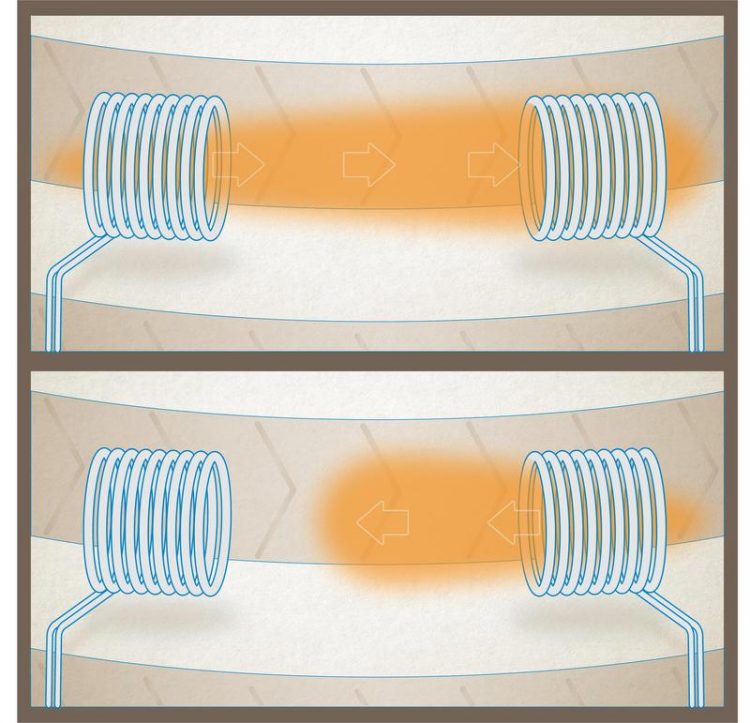First diode for magnetic fields

When the left coil is energized, the magnetic field reaches the right coil (top). When the right coil is energized, the magnetic field does not reach the left one (bottom). Luis Veloso
Electric diodes are essential electronic components that conduct electricity in one direction but prevent conduction in the opposite one. They are found at the core of any electronic component, being one of the most essential building blocks.
Until now there were no such components for magnetic fields. Physicists at the University of Innsbruck and the ÖAW Institute of Quantum Optics and Quantum Information (IQOQI) are now changing that. They designed the first diode for magnetic fields and demonstrated its functionality in the laboratory.
“Our device makes possible to transfer the magnetic field from a first magnetic element – for example a magnet or a coil – to a second one. When roles are inverted and one tries to send magnetic field from the second to the first, no magnetic field is transferred,” explains first author Jordi Prat Camps, who is now a researcher at the University of Sussex in England.
Technically speaking, this means that the mutual inductances between the two sources, which are routinely assumed to be symmetric, can be made extremely asymmetric. The key element to obtain this result is the use of an electrical conductor that moves with constant velocity.
“When the conductor is properly placed near to the magnetic elements and is moved at the right speed, the coupling between them becomes unidirectional, and a diode for magnetic fields is realized”, says Jordi Prat Camps.
Coupled magnetic elements are found in many key technologies like electric motors, transformers, magnetic memories or MRI machines. In all of them, magnetic elements are symmetrically coupled.
“The availability of a new magnetic tool like a diode might thus open a bunch of new possibilities”, Gerhard Kirchmair points to the future. For example, the efficiency of wireless charging devices could be improved, since the energy can only flow from the charging station to the device and not in the other direction.
The work was financially supported by the Austrian Ministry of Education, Science and Research and the European Union and published in the journal Physical Review Letters.
Jordi Prat-Camps
Interact Lab
University of Sussex
phone: +44 01273872642
email: J.Prat-Camps@sussex.ac.uk
web: http://pratcamps.weebly.com
Circumventing Magnetostatic Reciprocity: A Diode for Magnetic Fields. J. Prat-Camps, P. Maurer, G. Kirchmair, and O. Romero-Isart. Phys. Rev. Lett. 121, 213903 DOI: https://doi.org/10.1103/PhysRevLett.121.213903
https://physics.aps.org/synopsis-for/10.1103/PhysRevLett.121.213903 – Physics Synopsis: One-Way Transfer of Magnetic Fields
https://iqoqi.at/en/group-page-romero-isart – Quantum Nanophysics, Optics and Information (Oriol Romero-Isart)
https://iqoqi.at/en/group-page-kirchmair – Superconducting Quantum Circuits (Gerhard Kirchmair)
Media Contact
More Information:
http://www.uibk.ac.atAll latest news from the category: Physics and Astronomy
This area deals with the fundamental laws and building blocks of nature and how they interact, the properties and the behavior of matter, and research into space and time and their structures.
innovations-report provides in-depth reports and articles on subjects such as astrophysics, laser technologies, nuclear, quantum, particle and solid-state physics, nanotechnologies, planetary research and findings (Mars, Venus) and developments related to the Hubble Telescope.
Newest articles

Bringing bio-inspired robots to life
Nebraska researcher Eric Markvicka gets NSF CAREER Award to pursue manufacture of novel materials for soft robotics and stretchable electronics. Engineers are increasingly eager to develop robots that mimic the…

Bella moths use poison to attract mates
Scientists are closer to finding out how. Pyrrolizidine alkaloids are as bitter and toxic as they are hard to pronounce. They’re produced by several different types of plants and are…

AI tool creates ‘synthetic’ images of cells
…for enhanced microscopy analysis. Observing individual cells through microscopes can reveal a range of important cell biological phenomena that frequently play a role in human diseases, but the process of…





















